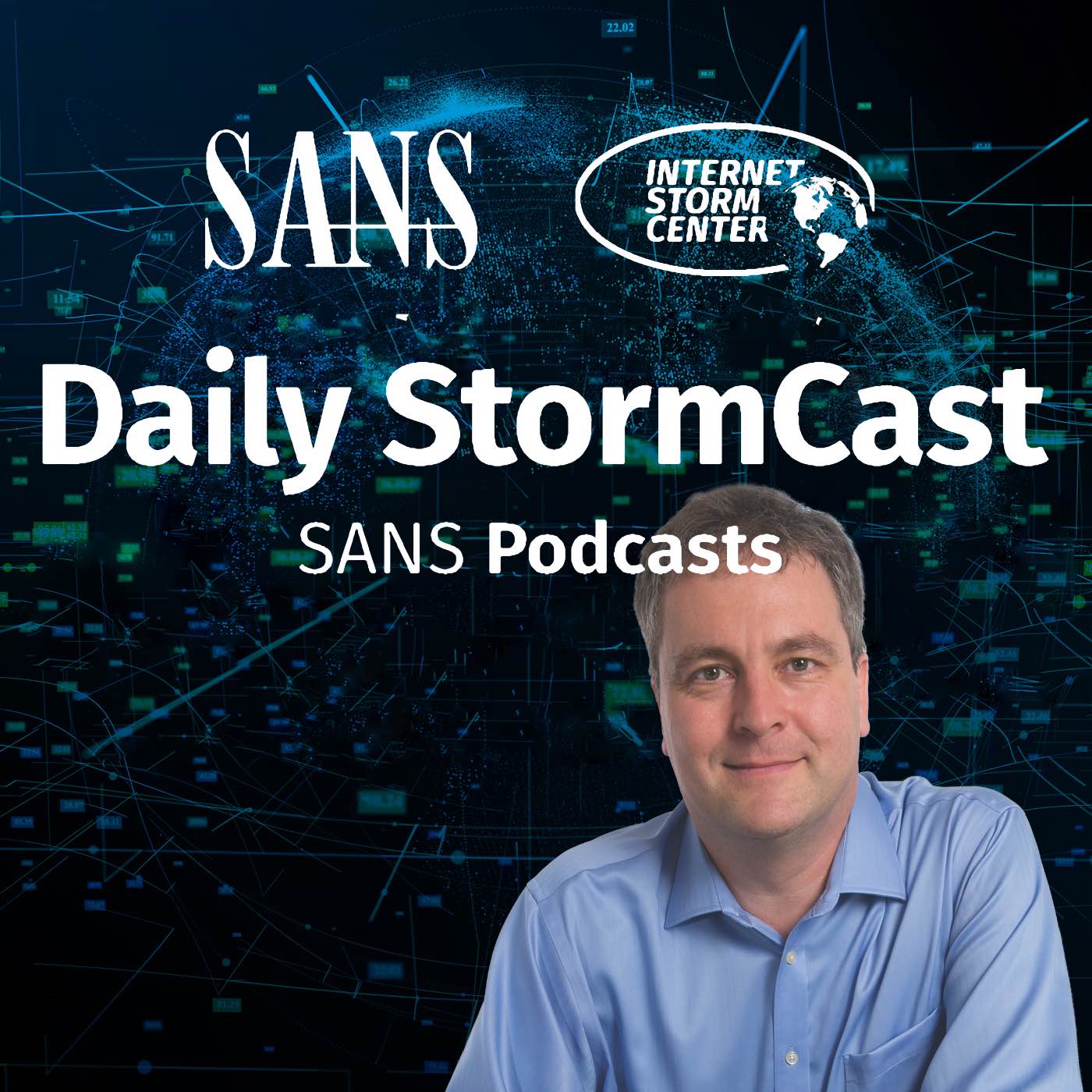Handler on Duty: Brad Duncan
Threat Level: green
Podcast Detail
SANS Stormcast Friday, May 30th 2025: Alternate Data Streams; Connectwise Breach; Google Calendar C2;
If you are not able to play the podcast using the player below: Use this direct link to the audio file: https://traffic.libsyn.com/securitypodcast/9472.mp3
My Next Class
| Network Monitoring and Threat Detection In-Depth | Online | Central European Time | Dec 15th - Dec 20th 2025 |
| Application Security: Securing Web Apps, APIs, and Microservices | Orlando | Mar 29th - Apr 3rd 2026 |
Alternate Data Streams: Adversary Defense Evasion and Detection
Good Primer of alternate data streams and how they are abused, as well as how to detect and defend against ADS abuse.
https://isc.sans.edu/diary/Alternate%20Data%20Streams%20%3F%20Adversary%20Defense%20Evasion%20and%20Detection%20%5BGuest%20Diary%5D/31990
Connectwise Breach Affects ScreenConnect Customers
Connectwise’s ScreenConnect solution was compromised, leading to attacks against a small number of customers. This is yet another example of how attackers are taking advantage of remote access solutions.
https://www.connectwise.com/company/trust/advisories
Mark Your Calendar: APT41 Innovative Tactics
Google detected attacks leveraging Google’s calendar solution as a command and control channel.
https://cloud.google.com/blog/topics/threat-intelligence/apt41-innovative-tactics
Webs of Deception: Using the SANS ICS Kill Chain to Flip the Advantage to the Defender
Defending a small Industrial Control System (ICS) against sophisticated threats can seem futile. The resource disparity between small ICS defenders and sophisticated attackers poses a significant security challenge.
https://www.sans.edu/cyber-research/webs-deception-using-sans-ics-kill-chain-flip-advantage-defender/
Discussion
New Discussions closed for all Podcasts older than two(2) weeks
Please send your comments to our Contact Form
| Network Monitoring and Threat Detection In-Depth | Online | Central European Time | Dec 15th - Dec 20th 2025 |
| Application Security: Securing Web Apps, APIs, and Microservices | Orlando | Mar 29th - Apr 3rd 2026 |
| Network Monitoring and Threat Detection In-Depth | Amsterdam | Apr 20th - Apr 25th 2026 |
| Application Security: Securing Web Apps, APIs, and Microservices | San Diego | May 11th - May 16th 2026 |
| Network Monitoring and Threat Detection In-Depth | Online | Arabian Standard Time | Jun 20th - Jun 25th 2026 |
| Network Monitoring and Threat Detection In-Depth | Riyadh | Jun 20th - Jun 25th 2026 |
| Application Security: Securing Web Apps, APIs, and Microservices | Washington | Jul 13th - Jul 18th 2026 |
Podcast Transcript
Hello and welcome to the Friday, May 30th, 2025 edition of the SANS Internet Storm Center's Stormcast. My name is Johannes Ullrich and this episode brought to you by the SANS.edu graduate certificate program in incident response is recorded in Jacksonville, Florida. And today's diary comes again from one of our undergraduate interns. And well, it's a good summary of alternate data streams, basically what they are, how to defend against them, how they're being used offensively. Keep in mind that alternate data streams aren't always malicious. There are some normal occurrences of alternate data streams. Well, that's why they exist in the first place. They were really initially sort of meant to sort of annotate files. So one way how they're being used, for example, is as part of the mark of the web to basically define a certain file was downloaded from the Internet. And then you may find additional details like, for example, the URL that it is being downloaded from. Anyway, if you're not that familiar with alternate data stream, it's a real good primer here on what they can do and how to better understand them. And ConnectWise published an advisory stating that they have been breached. The problem with this is that, well, one of their problems, Screen Connect, was apparently affected. Now, they're stating only a small number of customers were affected. But this is really sort of a current trend where these remote access tools are often being compromised to then gain access to victims' systems. I talked yesterday about some of the issues with MSPs. And there we had simple help as sort of the entry vector. Of course, the more traditional tools like RDP and such are also at the top of the list of what attackers are looking for. Only a one-paragraph advisor here from ConnectWise with not a lot of details. So don't really know exactly how many customers or how the bridge exactly evolved or how you could figure out whether or not you are affected. They are supposed to reach out to affected customers. And Google's threat intelligence group has a nice write-up about APT41 and what they're up to these days. That's sort of one of the, I would say, older at this point, established APT groups commonly associated with China. And one of the new tricks they're using is to use Google Calendar as a command and control channel. In order to do that, they set up zero -minute events. So it's not really that visible at the specific date. And then just basically exfiltrate data as nodes to that date. This is the typical difficult-to -detect kind of command control channel. It's just sort of mixed in with all the other traffic that you probably are seeing to Google. Also, the rest of the infrastructure is pretty much in Cloudflare, another provider that's used for a lot of normal traffic. So really difficult to distinguish them. Probably your best bet is, well, trying to detect these odd calendar events if you have any visibility into that. Or then, of course, just look for data volume. And yes, the initial spear phishing email. But, well, they have their own sort of usual difficulties in actually detecting them proactively. Don't read too much into the details of the indicators of compromise being shown here. Like, for example, the exact date being used for these calendar invites. That's going to change if probably has already changed. So that'll only help you find some of the older attacks, not anything current. Well, and it's Friday again. So we do have yet again another Sanson EDU student to talk about some of our research projects. Oren, could you introduce yourself, please? Oren, could you introduce yourself, please? My name is Oren Miskin. I live in Houston, Texas. I've been in the industrial control system, cybersecurity realm for probably 20 years, starting off as an electrician, actually, on a nuclear aircraft carrier with the Navy. And I kind of worked my way up the Purdue model, I like to say, until eventually I was running an OT security program for a large drilling contractor, oil drilling here. And that's what brought me to Houston. And then I got sick of making an honest living and I moved to consulting. So I worked at EY for a few years and now I'm at GuidePoint Security. I'm really liking it. Yeah. And your paper was also the industrial control systems. As I said, some people are worried about the lights coming in the morning. I'm more worried about my coffee maker. But so what was the paper about there? So the paper, after working in industrial control system security on the blue team and the red team, what I noticed is there's a lot of concentration on finding targets once they're inside the OT network. So OT cares about the OT network. IT cares about the IT network. And never the two meet. And what I noticed, though, working on these red teams, especially at GuidePoint where I'm at now, is there's a lot of activity that happens on the IT side that I think was really useful to be able to catch attacks before they hit the OT network. And that means if you can catch them in IT, it's much cheaper to respond to, less disruptive, much safer, less risk of causing an industrial incident. And that's what the paper is about. It's finding ways to, using deception, to trick attackers into revealing themselves in the IT network. And then you can block them before they ever touch your OT network. Yeah. A little bit like shifting left in the ICS world. Is this sort of... Exactly. Yeah. The earlier we get it, the faster, the cheaper we can remediate it. Is the IT network interesting because that sort of really connects your network to the internet? So that's the exposure? Yeah. I think like a typical attack chain is somebody in the IT network gets phished. And now they have credentials in the IT side. And they start enumerating the IT network users and groups. And they discover OT resource or paths to OT from the IT network. Usually the compromise of OT network starts in IT. So they get in the IT network and they start looking around for systems that can get them to IT and users and juicy files like, you know, turbine safety specifications or, you know, a contamination spill response plan. And they exfiltrate these things. And we've seen it over and over again in these attacks. They exfiltrate them and then use them later in the attack. And deception, how does that fit in? Like I use it, of course, heavily for research purposes. But how do you sort of make that work in your networks? So I got turned on to this by John Strand's YouTube videos. And what he does is he sets up, let's say, the three deception tactics I focused on was deceptive files, users and systems. So first of all, you should segment your OT network from your IT network. So you don't have OT. You have OT in its own boundary that access is controlled in and out of. So a user on the IT side should not be able to manipulate things on the OT network. Well, once you have that in place and the attackers are looking for systems and resources in OT, you could place fake systems, fake users and fake files that look really juicy to the attackers. And when they interact with them, it raises an alert. So in the research, I said I had a fake file that said remote access instructions. And this is a typical thing. We were just on an assessment a few weeks ago and found a file that's something like how to enroll in multi-factor for OT. And so the red team I was with, of course, they got super excited. And you could see their faces light up like, oh, we found something. And they downloaded that file. And so my research says you could do the same thing, but just the file is not legitimate. And when somebody accesses this file, then it sends you an alert. And I think what John Strand was saying is if you only have that on a few files that normal people wouldn't access, but an attacker searching the file system for strings, searching the file system for interesting things to them might trip over this and let you know they're there. And I think that's really the hard part with this deception techniques. You want the attacker to find them, but you don't want the false positives from some regular user who just forgot how to enroll in two-factor authentication, doing sort of a random search on the file system and coming across that file. How do you balance that? Any tricks here that you learned? And the paper focused on small organizations. So I was figuring if you have a small organization of like 100 people or something like that, the engineers that are going to be accessing the areas that I think pretty, you could tune out the noise pretty quickly. Like people that are working in these systems would may trigger it once or twice, but after a while, they'll know that's the decoy and they won't touch it. But if you had a large multinational industrial organization, I could see that being a huge challenge. Yeah, it may actually help. I always think that deception is a little bit overlooked because it doesn't create false positives. Most of our security controls, they kind of show value by ever so often triggering alerts. And if you have a control like deception, it never triggers anything. I guess that reminds me that it's still working if you get these false positives ever so often. Yeah. Any then tips how you react, how you respond to this? Yeah, that's the main benefit is that you get to respond to this while they're still in the IT network so that you can eject them from the IT network. Because once they're in OT, now you have to worry like if they compromise the OT user and you boot that OT user, is that user logged into some processes that will affect operations? Or if you stop processes, it can get complicated and takes longer and more risky to respond. But yeah, responding to these incidents in the IT side, one important thing to add is sharing it with the community. So once you discover some actor searching for OT systems in your IT side and you get some intelligence on that, you could share it with the information sharing agencies like the Water ISAC or the Power ISAC. And if they're sharing with you, then it builds like a community defense. And all this is before the OT network is even reached, which is really good. But yeah, tuning is probably the most challenging part of this. There's dealing with those false positives, maybe dealing with scanning tools that touch every file. Or I could see that being an issue. But once an alert is triggered, it seems like the response is much simpler than if it were a legitimate attack on the OT side. But the challenge is, of course, merging the two security teams, IT and OT, to communicate and respond effectively. That's the main challenge, I think. Yeah, and I'm not sure if the Windows or IT response teams like that, you call their life easy. But it's probably easier than doing the same thing in OT, where you have much less access and the tools and such for systems. I don't think their life is easy at all. So there's a lot of action going on in the IT side. But for an OT incident specifically, they have a lot of pressure. Yeah, great talk to you. Great paper. And the link to the paper will be in the show notes. Any final words, anything you're working on right now that people may be interested in? So, yeah, I'm doing my new research I'm trying to work out is discovering dual home systems in OT. So this is another thing I see a lot in assessments is people having a system that has one leg in the IT network and one leg in the OT network. And it's really hard to find these because our tools only monitor the OT network. And so how do you find that second network card that's attached to another network, maybe even the Internet? Interesting. So thanks for joining me here. And thanks for listening. And hope everybody has a good weekend and talk to you again on Monday. Bye.











